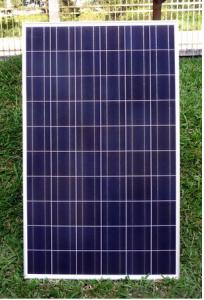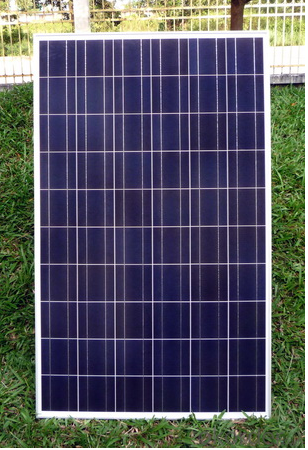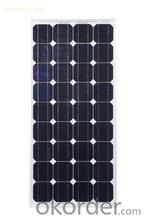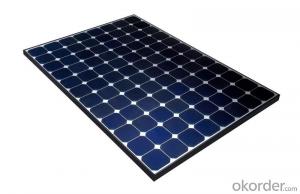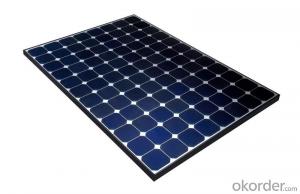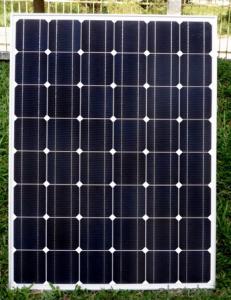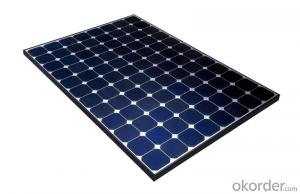Eclipse Series CNBM Poly 175W Solar Panel with TUV UL CE Certificate for Residential
- Loading Port:
- Shanghai
- Payment Terms:
- TT OR LC
- Min Order Qty:
- 100 watt
- Supply Capability:
- 1000 watt/month
OKorder Service Pledge
OKorder Financial Service
You Might Also Like
Specification
CNBM Poly 170W Solar Panel with TUV UL CE Certificate For Residential
Introduction
Solar modules use light energy (photons) from the sun to generate electricity through the photovoltaic effect. The majority of modules use wafer-based crystalline silicon cells or thin-film cells based on cadmium telluride or silicon. The structural (load carrying) member of a module can either be the top layer or the back layer. Cells must also be protected from mechanical damage and moisture. Most solar modules are rigid, but semi-flexible ones are available, based on thin-film cells.
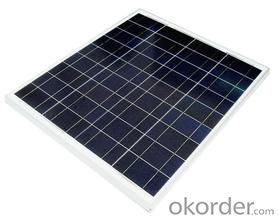
Suggested application
Home lighting business lighting,
Garden lighting, pavement lighting
Farmer household lighting
Decorative water pump
Traffic signal lighting
Industry area
Business area
Solar Power Plant
Product feature
Modules are made of Monocrystalline or Polycrystalline Silicon cell.
Materials and color of the solar panel frame: Clear anodized aluminum alloy type 6063T5 Universal frame; Silver-white color;
The output connection gathers the coupling: Selects conforms to the IEC-612615; 2005, class II, IEC61730 international standard; Airtight waterproofing binding clamp;
Module seal structure: The surface is thick, the high diaphanous rate armored glass with solar cell board special-purpose 3.2mm becomes after the high temperature lamination craft. The back selects has waterproof and anti- aged performance fine TPT materials. The entire block battery board has, the waterproofing, the anti- aging airtight and so on the fine performance;
Power tolerance: +/-3%
Packaging
International standard cartons (according to the requirements of customers)
- Q: i need how a solar panel works, if possible make as easy to understand as possible like because of this , this happens and if you could please put a web source you got it from
- Sunlight (photons) hit a piece of silicon and knock electrons out of it. That causes a flow of electrons, which is electrical current. simple enough? a better explanation from wikipedia: A solar cell is a device that converts the energy of sunlight directly into electricity by the photovoltaic effect. Sometimes the term solar cell is reserved for devices intended specifically to capture energy from sunlight such as solar panels and solar cells, while the term photovoltaic cell is used when the light source is unspecified.
- Q: I'm writing a post-apocalyptic story in it the main character finds a warehouse. Eventually he finds out the roof is covered with commercial solar panels. Given it's been over a year since the majority of the world died no manainence was done, do they still work?
- In my experience working with solar panels, I've found that the panels themselves are robust and can last years. How that energy is transferred from the panel to perform work (sorry for the boffinism) is where the complexity emerges, namely due to the fact solar panels produce DC current, and nearly all of our electrical appliances use AC current. In most cases, solar panels will either send energy through a DC/AC inverter directly to be used for appliances, or stored in deep cycle batteries, then converted to AC using an inverter when the user wants to use his/her appliance. Now to answer your question: the solar panels will be fine, and could conceivably be in fine working order with AC current available IF... and I cannot stress this enough (namely through years of field experience dealing with solar powered scientific instrumentation that was working well and then mysteriously not working)... IF rats and other rodents haven't eaten through the wires. This is probably the most likely reason that a set of solar panels wouldn't be working in your given scenario. Hope this helps, and good luck!!
- Q: I've been figuring ways to keep water thawed out this winter, and this bucket seems to be the easiest thing. What kind of set up (solar panel) would I need to feed this 260 watt heated bucket?
- Unfortunately solar panels are low output,generally only 2 volt and very low amperage,so you would need to build a multi panel array with a DC-AC converter all together costing several hundred dollars which would only work during sunlight.Just roughly figuring,about $800. Plan2-Solar charger,battery bank,and DC-AC inverter so it would work 24hrs a day,also several hundred $$. Solar power does just not seem feasible(to me)in this application.By far the cheapest set up here would be an extension cord fromhouse to the bucket.260 watts per hr is a fairly lightweight draw,even not figuring the thermostat's cycling it on and off as needed.Electricity is sold in kilowatt hours(000W/hr).This bucket would use(not allowing for thermostats control lowering it)appx 6000watts or 6KW per day.Depending on your electrical cost per Kwh it would cost very little to run.(In my location appx 50cents a day) or appx the same amount as my computer(325watts total)) Note that that would be a maximum rate,and would actually be less due to thermostat cycling off and on as needed.
- Q: Can solar panels work in the shade?
- They will work somewhat in the shade but they really work best in direct sunlight. I have solar panels on my home and just a cloud passing over will cause the output to drop quite a bit.
- Q: How are solar panels installed?
- Solar panels are typically installed on rooftops or in open areas with maximum exposure to sunlight. The process involves mounting the panels onto a structure, such as a roof or frame, using brackets and screws. The panels are then connected to an inverter, which converts the direct current (DC) generated by the panels into usable alternating current (AC) electricity. Wiring and electrical connections are made to connect the solar system to the home or the grid.
- Q: I am looking to run 2 basic shoplights, each with 2- 32 watt T8 flourecent tubes for 6 hours a day for an indoor garden. Location WI.
- Lets say, for a simple approximation, that the 45 watt panel produces 45 watts /3 of the time and nothing the rest of the time. Each day, this will produce 8 hours times 45 watts = 360 watt hours. Also assume the battery charge controller and inverter waste half of that power, leaving 80 watt hours per day. If you use compact fluorescent lamps, that would allow you to burn 80 watts worth for an hour every day, or 90 watts for 2 hours, etc. That is a lot of light for a shed. You might consider using much less efficient tungsten filament lamps, but eliminate the inverter and choose low voltage (automotive) lamps that can run directly across the battery and lower the total cost, but give you only about half the light times time. The main advantage of the inverter might be that it would allow you to use small power tools or appliances in the shed. -- Regards, John Popelish
- Q: Can solar panels be installed on a community center or recreational facility?
- Yes, solar panels can definitely be installed on a community center or recreational facility. In fact, these types of public buildings are ideal candidates for solar panel installations due to their large roof spaces and high energy consumption. By harnessing solar energy, these facilities can reduce their carbon footprint, lower energy costs, and set a green example for the community.
- Q: I have four power packs for solar lights. They have 3 AA .2volt batteries of 2450 mAh capacity installed in series for a total supply voltage of 4 volt maximum for the lights. I want to charge all four packs at once off a single 6 volt solar panel. With the four packs wired in parallel, what capacity output (wattage) panel do I need to charge the batteries in an 8 hour day?
- 325 mAh+ losses so maybe 3.2Ah to 3.5Ah.
- Q: lately i have been interested in solar power. i own my own home and in Texas it's HOT, so my A/C is always on and that light bill is like $300.00 a month. i was looking at other light companies but then i remembered that there are the so called solar power but i dont knowknow to start or how it would work to power the a/c machine...pls help
- Then search the internet for the best prices on a GTS grid tie system.
- Q: How do solar panels affect the property's corporate social responsibility?
- Solar panels have a positive impact on a property's corporate social responsibility (CSR) by reducing its carbon footprint and reliance on fossil fuels. By generating clean and renewable energy, solar panels contribute to sustainability efforts, promote environmental stewardship, and demonstrate a commitment to reducing greenhouse gas emissions. Additionally, solar panels can enhance the reputation of a property, attract environmentally conscious stakeholders, and align with CSR goals of promoting renewable energy and protecting the planet.
Send your message to us
Eclipse Series CNBM Poly 175W Solar Panel with TUV UL CE Certificate for Residential
- Loading Port:
- Shanghai
- Payment Terms:
- TT OR LC
- Min Order Qty:
- 100 watt
- Supply Capability:
- 1000 watt/month
OKorder Service Pledge
OKorder Financial Service
Similar products
Hot products
Hot Searches
